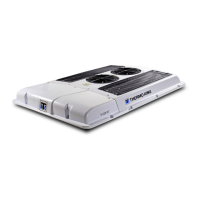96
TK 54343-18-MM-EN
Liquid Line Check Valve Replacement
Removal
1. Recover the refrigerant charge.
2. Disconnect the ORS nut at the end of the liquid line check valve tube assembly, unsolder the other end, and remove
the tube assembly from the unit.
Installation
1. Coat the new O-ring with refrigerant oil (same type that is used in the system) and place the new O-ring in the ORS
fitting on the end of the drier.
2. Place the liquid line check valve tube assembly in position and tighten the ORS nut. Use a backup wrench on the hex
on the drier.
3. Solder the connection on the other end of the liquid line check valve tube assembly.
4. Pressurize the system and test for leaks.
5. If no leaks are found, evacuate the system.
6. Recharge the unit with the proper refrigerant.
Discharge Check Valve (Model 20 and 50 Only)
Testing the Discharge Check Valve
Model 20 and 50 units are equipped with a discharge check valve. It isolates the engine driven compressor from the
electric standby compressor, ensuring the compressor oil and refrigerant do not migrate between compressors. The
check valve should be tested when the system is initially charged and operating, and anytime the system has been
opened for service or repair. Testing the check valve requires two gauge manifold sets.
1. Disconnect the liquid injection solenoid valve wires.
2. With the unit off, install a gauge manifold set on each compressor.
3. Observe the gauge manifold readings of the electric compressor. If the high side and low side readings are not the
same, open the gauge manifold valves and equalize the pressures. Close the gauge manifold valves.
4. Set the thermostat(s) so the unit will run in cool.
5. Start the truck and run the unit in Cool on the engine driven compressor.
6. Observe the gauge manifold readings of the engine driven compressor. The head pressure should increase and the
suction pressure should decrease.
7. Observe the gauge manifold readings of the electric standby compressor. The pressures should be approximately
equal to those on the engine driven compressor.
8. Turn the unit off and shut off the truck engine. Connect the remote control box to an appropriate electric power
source.
9. Observe the gauge manifold reading of the engine driven compressor. If the high side and low side readings are not
the same, open the gauge manifold valves and equalize the pressures. Close the gauge manifold valves.
10. Set the thermostat(s) so the unit will run in cool.
11. Start the unit and run it in Cool on electric standby.
12. Observe the gauge manifold readings of the electric standby compressor. The head pressure should increase and
the suction pressure should decrease.
13. Observe the gauge manifold readings of the engine driven compressor. The high side pressure should remain the
same as the pressure in step 9 after the high and low sides were equalized. If the high side pressure is increasing or
has increased noticeably, the discharge check valve is leaking internally. Stop the unit.
14. Remove the gauge manifold sets and the electric standby power source. Connect the wires to the liquid injection
solenoid valve.
15. If the discharge check valve is leaking internally it should be replaced, refer to the replacement procedure.
RReeffrriiggeerraattiioonn SSeerrvviiccee OOppeerraattiioonnss

